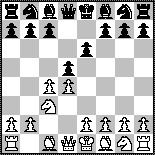
Admittedly, there are a few DDG variations in which Black can drive White in very difficult positions. The Queen's Gambit players who would like to try the DDG at times should note the following transposisitions.
1.d4 d5 2.c4 e6 3.Nc3 is the standard Queen's Gambit Declined (QGD).
B

After the following moves, White can easily transpose to wild and unexplored paths of the DDG:
This is the QGD, Charousek Variation (D31/23), and the standard move is 4.Nf3.
4.e4 dxe4 5.f3! transposes to a nice DDG line whereas 5.Nxe4 would allow Black equalize.
Moreover, there are other typical DDG moves available: 5.Be3, 5.Nge2 or 5.g3.
Now 4.e4 is the standard Semi-Slav, Marshall Gambit (D31/07). The normal continuation is 4...dxe4 5.Nxe4 Bb4+ 6.Bd2 Qxd4 7.Bxb4 Qxe4+ and so on. However, there is a great DDG line 5.f3!
As the c6-move does not much help Black, it is somewhat strange how the f3-sacrifice has not been mentioned in any Slav books. Eric Schiller calls 5.f3 the Gunderam Gambit in Unorthodox Openings (1998).
See Heikkinen - Davis, Internet Gaming Zone 1996.
Now 4.cxd5 exd5 5.e4 is the standard QGD, Tarrasch Defence, Marshall Gambit (D32).
5...dxe4 6.d5?! is a rare line, but played anyway. It is quite fascinating that exactly the same position can be reached in the DDG: 1.e4 e6 2.d4 d5 3.c4 dxe4 4.Nc3 c5 5.d5 exd5 6.cxd5. Keene assessed the gambit as doubtful, and gave it 2 stars out of 5 in The Complete Book of Gambits.
Among others, the line could transpose to the well-known Keres Variation via 6...Nf6 7.f3 exf3 8.Nxf3 Bd6. Also 6...f5 is considered strong.
Perhaps even more striking is that with one tempo down, Black can reach the reversed position in the Albin Counter-Gambit: 1.d4 d5 2.c4 e5 3.dxe5 d4 4.Nf3 c5 5.e3 Nc6. Tartakower was the most famous player of this c5 variation.